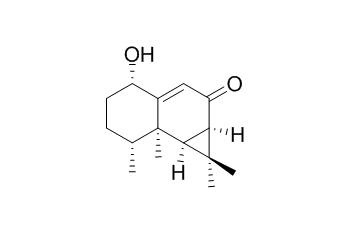Axinysone B
Axinysone B is a natiral product from the metabolites of the mushroom Anthracophyllum sp. BCC18695.
Inquire / Order:
manager@chemfaces.com
Technical Inquiries:
service@chemfaces.com
Tel:
+86-27-84237783
Fax:
+86-27-84254680
Address:
1 Building, No. 83, CheCheng Rd., Wuhan Economic and Technological Development Zone, Wuhan, Hubei 430056, PRC
Providing storage is as stated on the product vial and the vial is kept tightly sealed, the product can be stored for up to
24 months(2-8C).
Wherever possible, you should prepare and use solutions on the same day. However, if you need to make up stock solutions in advance, we recommend that you store the solution as aliquots in tightly sealed vials at -20C. Generally, these will be useable for up to two weeks. Before use, and prior to opening the vial we recommend that you allow your product to equilibrate to room temperature for at least 1 hour.
Need more advice on solubility, usage and handling? Please email to: service@chemfaces.com
The packaging of the product may have turned upside down during transportation, resulting in the natural compounds adhering to the neck or cap of the vial. take the vial out of its packaging and gently shake to let the compounds fall to the bottom of the vial. for liquid products, centrifuge at 200-500 RPM to gather the liquid at the bottom of the vial. try to avoid loss or contamination during handling.
Korean J. Crop Sci.2018, 63(2):131-139
Processes 2021, 9(5),894.
Institute of Food Science & Technology2021, 18 December.
Gene.2022, 815:146178.
Int J Mol Sci. 2014, 15(5):8443-57
Toxicol Res.2019, 35(4):371-387
Plant Physiol Biochem.2019, 144:355-364
Pharmaceuticals (Basel).2024, 17(4):462.
Int J Biol Macromol.2025, 292:139225.
Food Chem.2021, 337:128023.
Related and Featured Products
Nat Prod Commun. 2013 Mar;8(3):287-8.
New bioactive secondary metabolites from Bornean red alga, Laurencia similis (Ceramiales).[Pubmed:
23678792]
METHODS AND RESULTS:
A Bomean red algal population of Laurencia similis Nam et Saito was analyzed for its secondary metabolite composition. Seven compounds were identified: ent-1(10)-aristolen-9beta-ol (1), (+)-aristolone (2), Axinysone B (3), 9-aristolen-1alpha-ol (4), 2,3,5,6-tetrabromoindole (5), 1-methyl-2,3,5,6-tetrabromoindole (6), and 1-methyl-2,3,5-tribromoindole (7). Compound 1 was identified as a new optical isomer of 1(10)-aristolen-9beta-ol.
CONCLUSIONS:
Compounds 1, 4 and 5 exhibited good antibacterial activity against antibiotic resistant clinical bacteria and cytotoxic effects against selected cancer cell lines.
Phytochemistry Letters, 2013, 6(3):345-349.
Novel spiro-sesquiterpene from the mushroom Anthracophyllum sp. BCC18695[Reference:
WebLink]
METHODS AND RESULTS:
A novel spiro-sesquiterpene, anthracophyllic acid (1), and a new aristolane sesquiterpene, anthracophyllone (2), were isolated from the mushroom Anthracophyllum sp. BCC18695, together with seven known compounds including aurisins A (3), G (4), K (5), nambinone A, nambinone C, axinysone A, and Axinysone B. The relative configuration of 1 and the hitherto unknown absolute stereochemistry of 3 were determined based on X-ray spectroscopic data.
CONCLUSIONS:
Biological activities including antimalarial activity against Plasmodium falciparum K1 strain, antibacterial property against Bacillus cereus, and cytotoxicity against MCF-7, KB, NCI-H187, and Vero cells of the isolated compounds were also evaluated.



